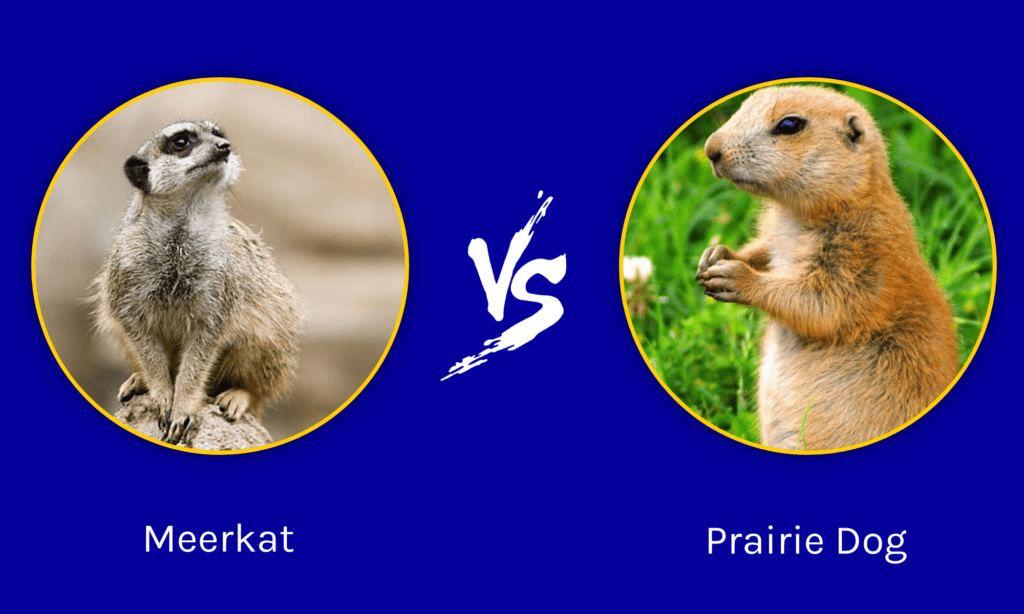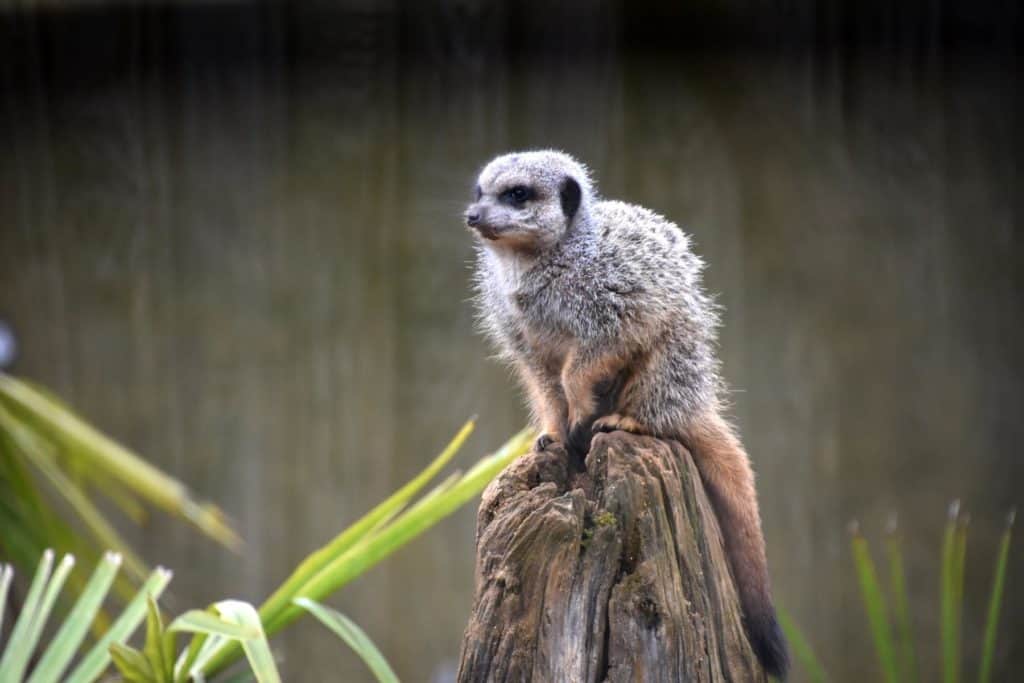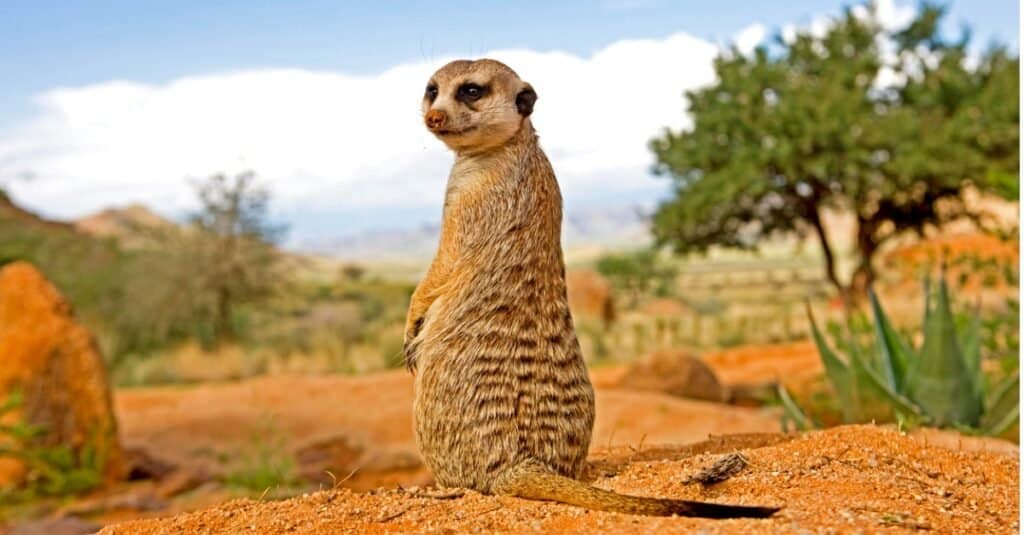Meerkats and prairie dogs are two mammals that are frequently confused for one another due to their similar habitats and behaviors. However, when you take a closer look at them, it becomes clear that they are very distinct. Today, we’re going to compare a meerkat vs prairie dog and show you the most significant differences between these creatures.
By the time we’re done here, you’ll know which burrowing creature is which and what sets them apart.
Comparing a Meerkat and a Prairie Dog

| Meerkat | Prairie Dog | |
|---|---|---|
| Size | Weight: 1.3 to 2.1 pounds Length: 10 to 14 inches, about 21 inches with tail | Weight: 1 to 4 pounds Length: 12 to 16 inches, including their short tails |
| Appearance | – Related to the mongoose – Rodent-like with a slim body, large eyes, pointed snout, and a skinny tail – Usually brown or tan in color – Markings on its face – Has eight stripes on its back | – Small, almond-shaped eyes – Short, strong legs with nails on their front and forelegs – Yellow buff fur with black hairs, and few markings aside from the tail in some species |
| Burrowing | – Create large burrow systems throughout plains areas or live in existing crevices – Burrows can exceed 16 feet in diameter and have over a dozen openings – Feature several layers of tunnels to help escape predators | – Form “towns” of different prairie dog families – Burrow systems can measure from 13 to 109 feet long and reach nearly 14 feet below ground. – Individual burrows are usually less than 15 feet long – Burrows systems have dozens of openings per acre – Towns can be spread out over large areas, some even exceeding 100 acres – Colonies can house several hundred different prairie dogs |
| Social Behavior | – Carnivorous – Very social creatures that form packs and then live in homes – Form groups of up to 30 individuals – Have an organized social hierarchy that includes subordinates watching over superiors’ babies – A guard stands watch and issues alarm calls to notify others of impending danger | – Herbivorous – Very social creatures – Form small groups, or coteries, consisting of a male, up to four females, and their offspring – Towns may have over 20 small family groups – Frequently groom one another – Guards “bark” to signal danger – Barks are specific to the predator, with specific calls including elements like color |
| Lifespan | – 10 to 15 years in captivity – 5 to 15 years in the wild | – 3 to 8 years in captivity – 3 to 4 years in the wild |
| Natural Range | – Southwest Africa | – North and Central America |
The Key Differences Between a Meerkat vs Prairie Dog
The greatest differences between a meerkat and a prairie dog include their appearance, burrowing habits, and lifespan. The meerkat is a relative of the mongoose that is brown or tan with many markings along its back and face that lives for 15 years and has a large burrow system for up to 30 individuals, but a prairie dog is an herbivorous creature that lives about 8 years, has yellow buff fur with few, if any markings, and lives in sprawling “towns” of burrows with over 100 individuals.
Of course, another obvious difference is their natural range. Meerkats live in the southwest nations of Africa, and prairie dogs live in North and Central America.
These are the easiest ways to tell these creatures apart, and we will delve deeper into these qualities.
Meerkat vs Prairie Dog: Size
Prairie dogs are slightly heavier than meerkats, but they are also shorter. Prairie dogs weigh about 1 to 4 pounds and grow between 12 and 16 inches long. Meerkats weigh between 1.3 pounds and 2.1 pounds, and they can grow up to 14 inches long when not counting their tail and 21 inches, including their tails.
Meerkat vs Prairie Dog: Appearance

Meerkats are scrawny creatures with long tails.
©Millie Bond – Copyright A-Z Animals
The meerkat is related to the mongoose, so it has a rodent-like look along with a pointed snout and skinny tail. The creature is brown or tan, and it has several markings on its body, including eight stripes going down its back and some markings on its face.
The prairie dog is another rodent-like creature with yellow buff fur, small, strong legs, almond-shaped eyes, and few markings. The black-tailed prairie dog has a black tail, though. So, if you see a creature with markings on its back and face, it’s probably not a prairie dog.
Meerkat vs Prairie Dog: Burrowing

Prairie dogs have large burrow systems.
©Zoltan Tarlacz/Shutterstock.com
The meerkat and prairie dog both burrow to stay safe and keep themselves out of the extreme weather. Generally speaking, greater numbers of prairie dogs live together than meerkats.
Meerkats create a burrow system in plains areas or live in existing rocky crevices. Their burrows can measure 16 feet in diameter and have many openings through which they can escape. Also, their burrows have several layers to give them a better chance of escaping encroaching predators.
Prairie dogs have larger burrow systems called towns. These can be spread out over 100 acres or more. The burrow systems can be over 100 feet long and 14 feet below the ground, depending on how many animals it is housing. Yet, individual burrows are only about 15 feet long. These burrows also have dozens of openings per acre of land to provide escape methods.
Meerkat vs Prairie Dog: Social Behavior
Meerkats are highly social animals with a set social hierarchy. The dominant creatures have their young taken care of by subordinates, and many factors affect their relationships with one another. These creatures form groups of up to 30, and they exhibit some potentially altruistic behavior. For example, a guard watches over the burrows and uses alarm calls to warn others of danger.
Much of the same can be said about prairie dogs, too. They are social creatures that live in small families of a male, up to four females and their young. Up to 20 of these family groups can occupy a single town, meaning that over 100 prairie dogs can inhabit the same area. Prairie dogs care for one another with frequent grooming and other social behaviors.
Prairie dogs also have guards that call out danger. Researchers have found that their calls are very specific. They can identify the type of danger, the color it is, and how quickly it is approaching!
Meerkat vs Prairie Dog: Lifespan
The meerkat lives much longer than the prairie dog. A meerkat can survive between 5 and 15 years in the wild and 10 to 15 years in captivity. One specimen even lived over 20 years! Prairie dogs are relatively short-lived, surviving between 3 and 8 years in captivity and 4 years in the wild due to weather, predators, and in-fighting.
Meerkat vs Prairie Dog: Natural Range

Meerkats’ natural range includes South Africa, Namibia, and Botswana.
©iStock.com/slowmotiongli
The meerkat lives in a few nations in the southwestern portion of Africa, including South Africa. Prairie dogs can be found in Canada, the United States of America, and Mexico.
All in all, meerkats and prairie dogs are very different creatures as long as you look at the minutiae between them. They are similar in many respects, but their looks and behaviors, while similar, are unique to them.
The photo featured at the top of this post is © Super Prin/Shutterstock.com
Thank you for reading! Have some feedback for us? Contact the AZ Animals editorial team.






